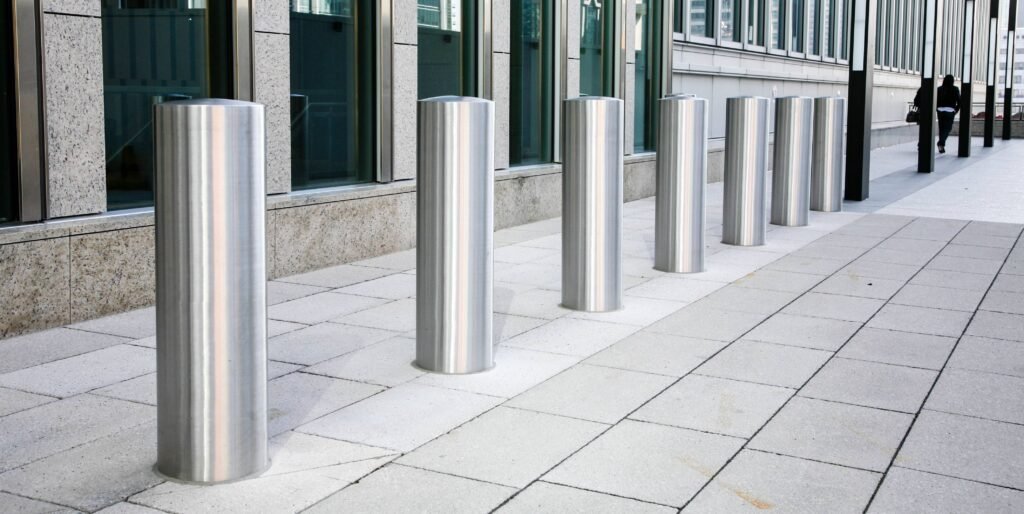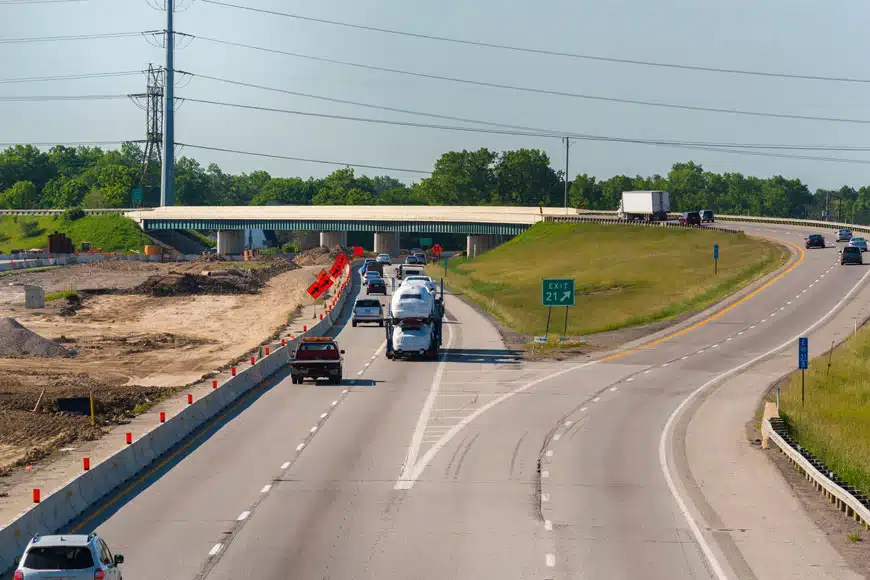Understanding Bollards: The Versatile Safety Solution
What Are Bollards?
Bollards are short, vertical posts strategically placed to act as barriers. They can control traffic, protect buildings, and provide pedestrian safety. While their primary function is security, bollards have evolved into versatile design elements, combining aesthetics and functionality.
Types of Bollards
- Fixed Bollards:
These are permanently installed into the ground, offering a robust solution for areas requiring high-security protection. Fixed bollards are ideal for storefronts, pedestrian zones, and critical infrastructure like power plants. - Removable Bollards:
These bollards offer flexibility, as they can be removed or repositioned when access is required. They are commonly used in areas with variable access needs, such as event spaces and private driveways. - Retractable or Telescopic Bollards:
Designed to be lowered manually or automatically, these bollards provide a sleek and modern solution for controlled entry points. Popular in commercial complexes and gated communities, they combine convenience with security. - Decorative Bollards:
With a focus on aesthetics, decorative bollards come in various styles and finishes, enhancing the visual appeal of urban spaces, parks, and historic sites. - Crash-Rated Bollards:
Engineered to withstand high-impact collisions, these bollards are used for anti-ram protection in high-security areas such as government buildings and airports.


Jersey Barriers: Heavy-Duty Protection for Critical Applications
What Are Jersey Barriers?
Jersey barriers are large, modular barriers made of concrete or reinforced plastic. They are primarily designed to redirect vehicles, manage traffic, and protect construction zones. With their heavy-duty construction, they provide unparalleled strength and durability.
Historical Significance of Jersey Barriers
The origin of the Jersey barrier lies in its name. The New Jersey State Highway Department commissioned its development in the 1950s. This invention was driven by a dire need to reduce head-on collisions on winding roads, particularly near Jugtown Mountain, notorious for its fatal accidents.
Early Research and Results:
- Engineers tested various configurations, focusing on height, material composition, and slopes to identify the optimal design.
- By raising the barrier to 32 inches, they observed a significant reduction in both collision frequency and severity.
Broader Influence:
Inspired by California’s efforts to manage traffic on the Grapevine Grade, New Jersey’s research helped refine the concept into what became the modern Jersey barrier, now used worldwide.
Features of Jersey Barriers
- High Durability: Concrete barriers can withstand significant impact, making them ideal for high-risk areas.
- Temporary or Permanent Use: While typically used for temporary setups like road construction, they can also serve as permanent barriers for long-term protection.
- Modular Design: These barriers can be linked together to form a continuous protective wall, ensuring comprehensive coverage.
Key Differences Between Bollards and Jersey Barriers
| Aspect | Bollards | Jersey Barriers |
|---|---|---|
| Design | Slim, vertical posts with various finishes | Large, block-like structures |
| Material | Stainless steel, iron, concrete, or plastic | Concrete or reinforced plastic |
| Mobility | Removable or retractable options available | Challenging to move, especially concrete types |
| Applications | Pedestrian safety, storefront protection | Traffic control, heavy-duty vehicle redirection |
| Customization | Highly customizable in design and finish | Limited to size and material variations |
| Aesthetic Appeal | Enhances the visual environment | Focused on functionality rather than aesthetics |
| Installation | Typically lightweight and easy to install | Requires heavy machinery for placement |
Applications of Bollards and Jersey Barriers
Applications of Bollards
- Traffic Management: Bollards guide vehicles and pedestrians in urban settings, ensuring order and safety.
- Storefront Protection: By preventing vehicle ramming, bollards safeguard commercial properties.
- Pedestrian Safety: Bollards create barriers between walkways and roads, reducing accident risks.
- Public Spaces: Decorative bollards enhance the appeal of parks, plazas, and campuses.
- High-Security Areas: Crash-rated bollards protect sensitive locations like embassies and data centers.
Applications of Jersey Barriers
- Road Safety: Used to separate opposing traffic lanes and prevent vehicle crossovers.
- Construction Zones: Provide a safe barrier for workers and equipment.
- Temporary Events: Create temporary boundaries for crowd control.
- High-Security Areas: Used for perimeter protection in military zones and airports.
- Flood Control: Some barriers are designed to channel or contain water during floods.
Why Stainless Steel Bollards Are the Superior Choice
Benefits of Stainless Steel Bollards
- Unmatched Durability: Stainless steel resists corrosion, weathering, and impact, ensuring longevity even in harsh environments.
- Low Maintenance: Unlike concrete or iron bollards, stainless steel requires minimal upkeep, reducing long-term costs.
- Aesthetic Versatility: Polished stainless steel offers a sleek, modern look that complements contemporary architecture.
- Sustainability: Stainless steel is recyclable, making it an eco-friendly option for sustainable infrastructure.
- High Customizability: Available in various sizes, finishes, and designs, stainless steel bollards can be tailored to fit specific needs.
Applications of Stainless Steel Bollards

- Urban Design: Used in cities to enhance safety and complement modern aesthetics.
- Commercial Spaces: Protect storefronts, parking lots, and loading docks.
- Public Infrastructure: Safeguard pedestrian walkways, bike lanes, and public squares.
- High-Security Zones: Anti-ram bollards protect sensitive facilities from vehicle attacks.
- Renewable Energy Projects: Used to secure solar farms, wind turbines, and other renewable installations.
Jersey Barriers vs. Stainless Steel Bollards: Which to Choose?
The decision between Jersey barriers and stainless steel bollards depends on the specific requirements of the project.
Choose Bollards When:
- Aesthetic appeal is important.
- Pedestrian safety is a priority.
- Flexibility in placement and design is needed.
- Vehicle control is required without obstructing visibility.
Choose Jersey Barriers When:
- Heavy-duty protection is essential.
- Temporary but sturdy solutions are required.
- The focus is on traffic management in high-risk zones.
- Large-scale perimeter protection is needed.
Jersey barriers are designed to handle impact at highway speed.


Innovations in Bollards and Barriers
- Smart Bollards: Equipped with sensors, smart bollards provide real-time data on traffic, weather, and security.
- Hydrogen-Powered Jersey Barriers: New materials are being developed to make barriers lighter and more eco-friendly.
- Green Bollards: Made from sustainable materials, these bollards combine environmental responsibility with security.
- Integrated Lighting: LED-lit bollards enhance visibility at night, increasing safety and reducing accidents.
The Future of Urban Safety
As cities grow and security challenges evolve, the demand for innovative safety solutions like bollards and Jersey barriers will only increase. Stainless steel bollards, with their durability, versatility, and modern appeal, are particularly well-suited for the future of urban safety.
Conclusion
Traffic barriers like bollards and Jersey barriers are vital for maintaining safety in public spaces and roadways. While Jersey barriers excel in high-impact scenarios, bollards—especially stainless steel variants—shine in urban, commercial, and mixed-use applications. Their durability, aesthetics, and adaptability make them a powerful tool for modern infrastructure needs.
References:
- Reliance Foundry: Bollards vs. Jersey Barriers
- Roadshark: Road Barriers – What Are They and How Are They Used?
Lux Metal: Your Trusted Partner for Stainless Steel Bollards
At Lux Metal, we specialize in crafting high-quality stainless steel bollards designed to enhance safety and elevate aesthetics. Whether for commercial spaces, public infrastructure, or high-security zones, our bollards are engineered to meet diverse needs.
Explore our range of stainless steel bollards and discover how we can help secure your spaces while enhancing their visual appeal. Visit us at Lux Metal.

